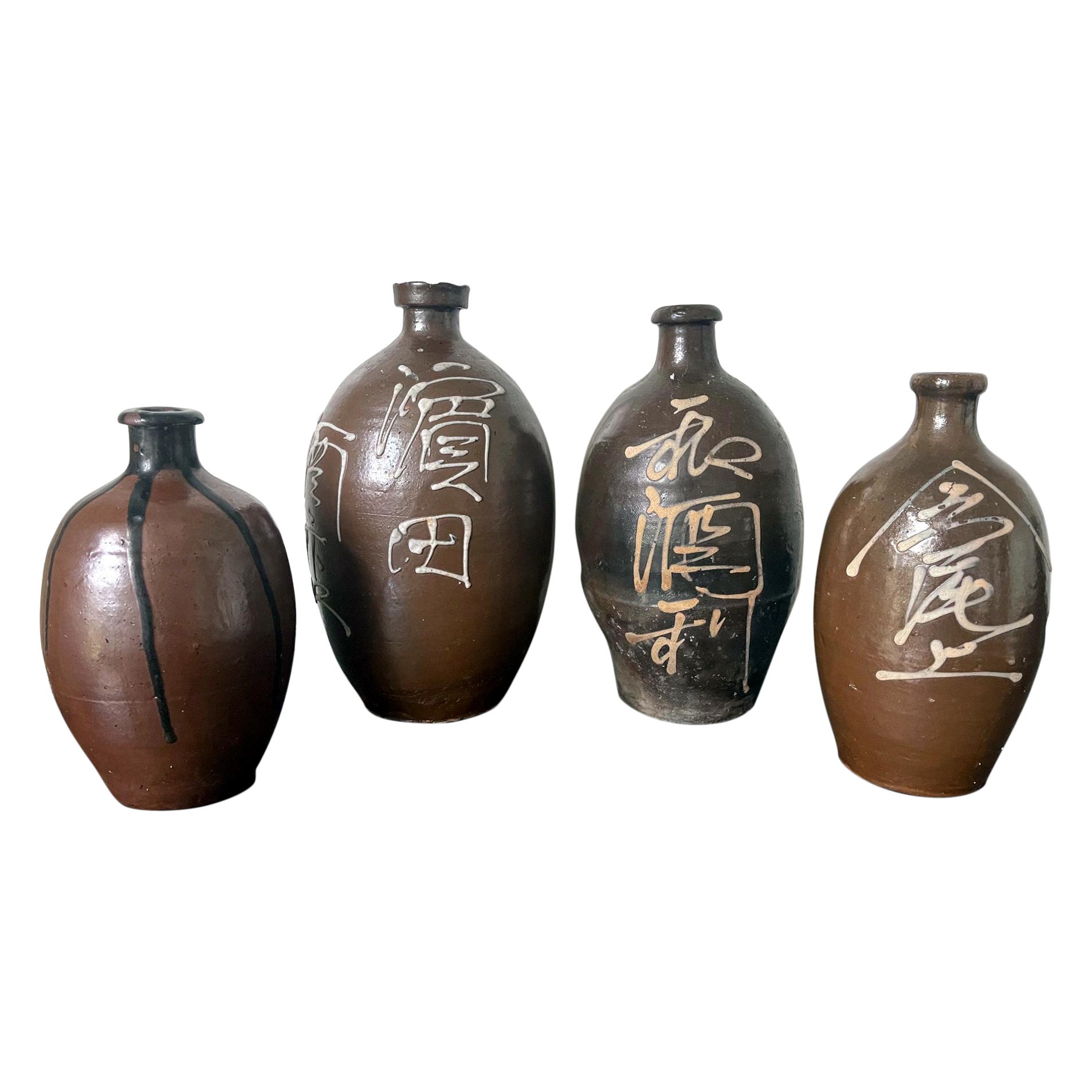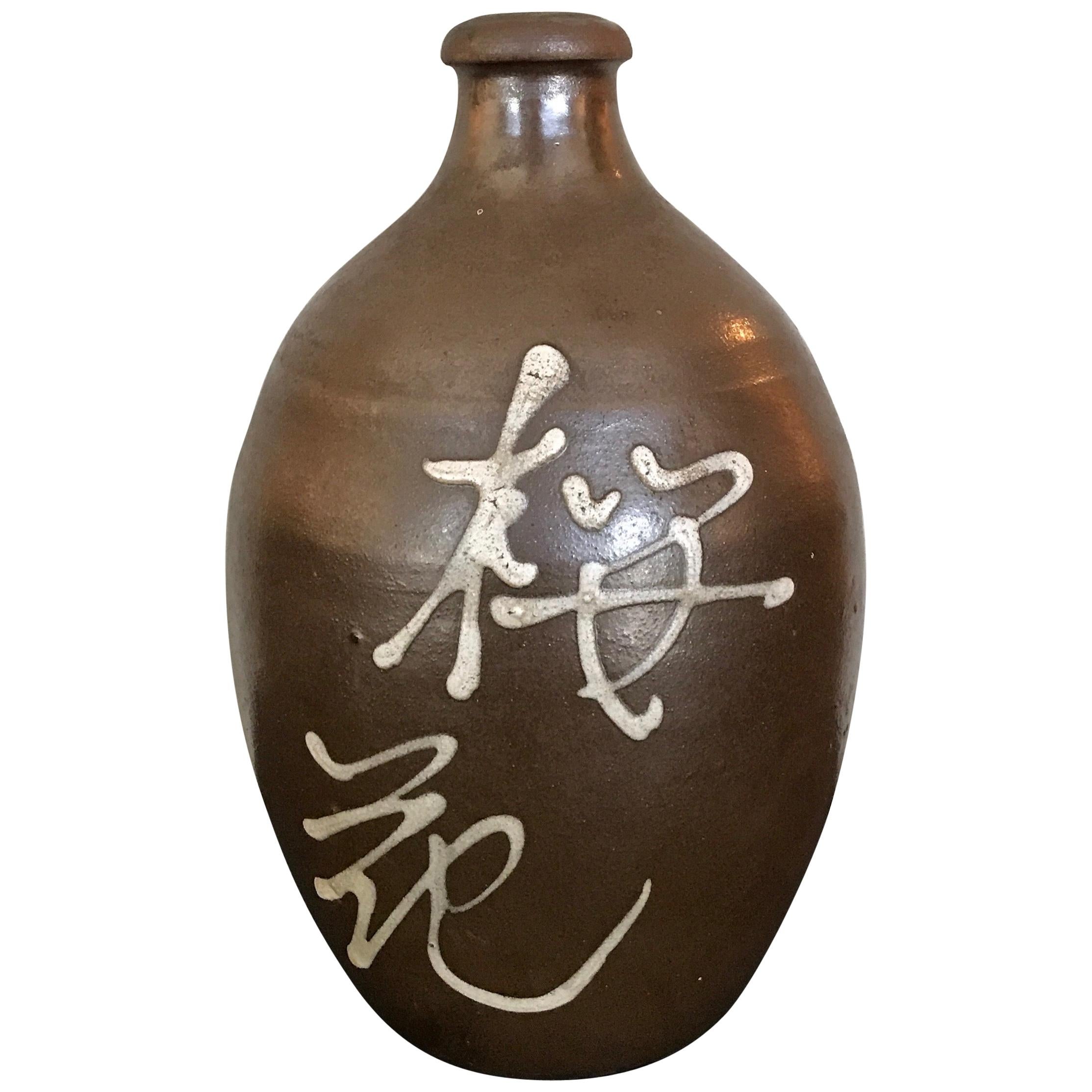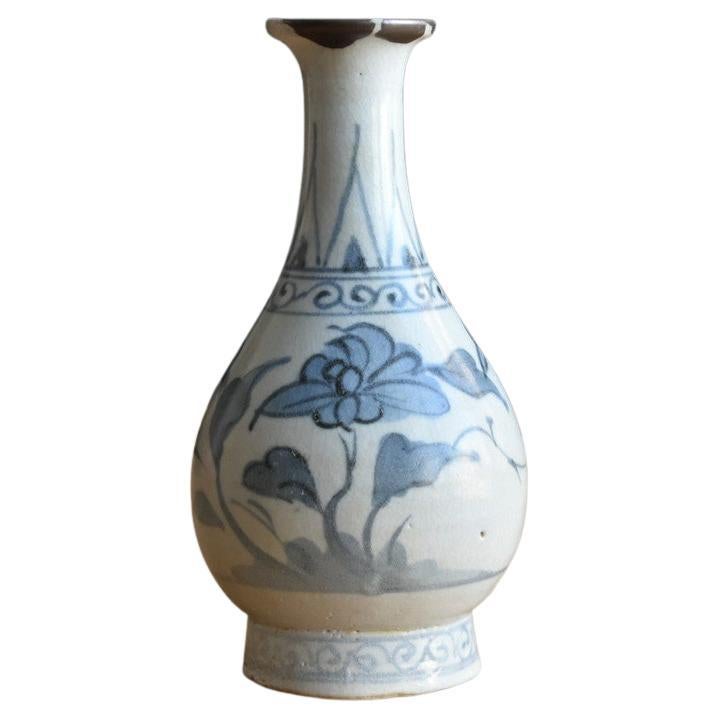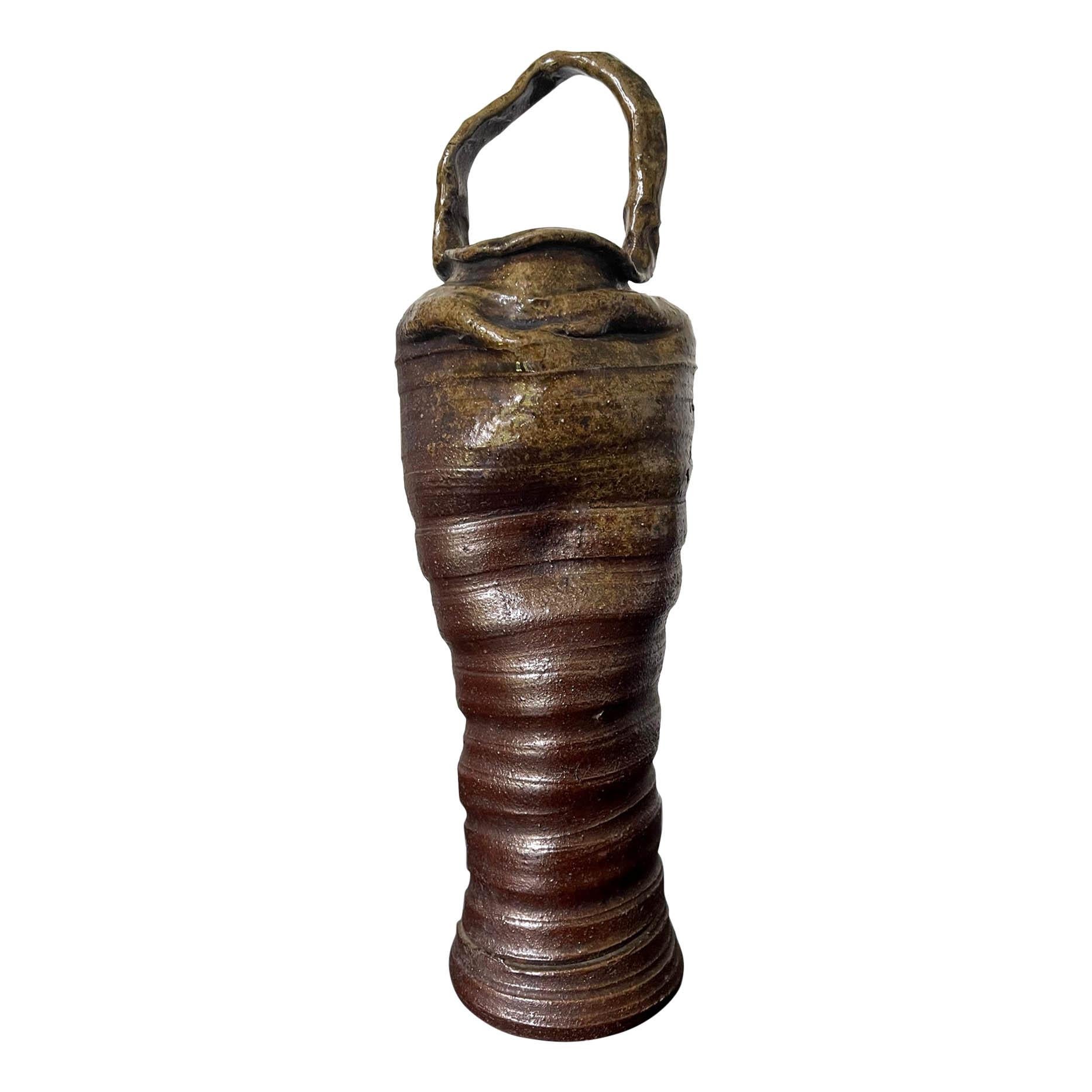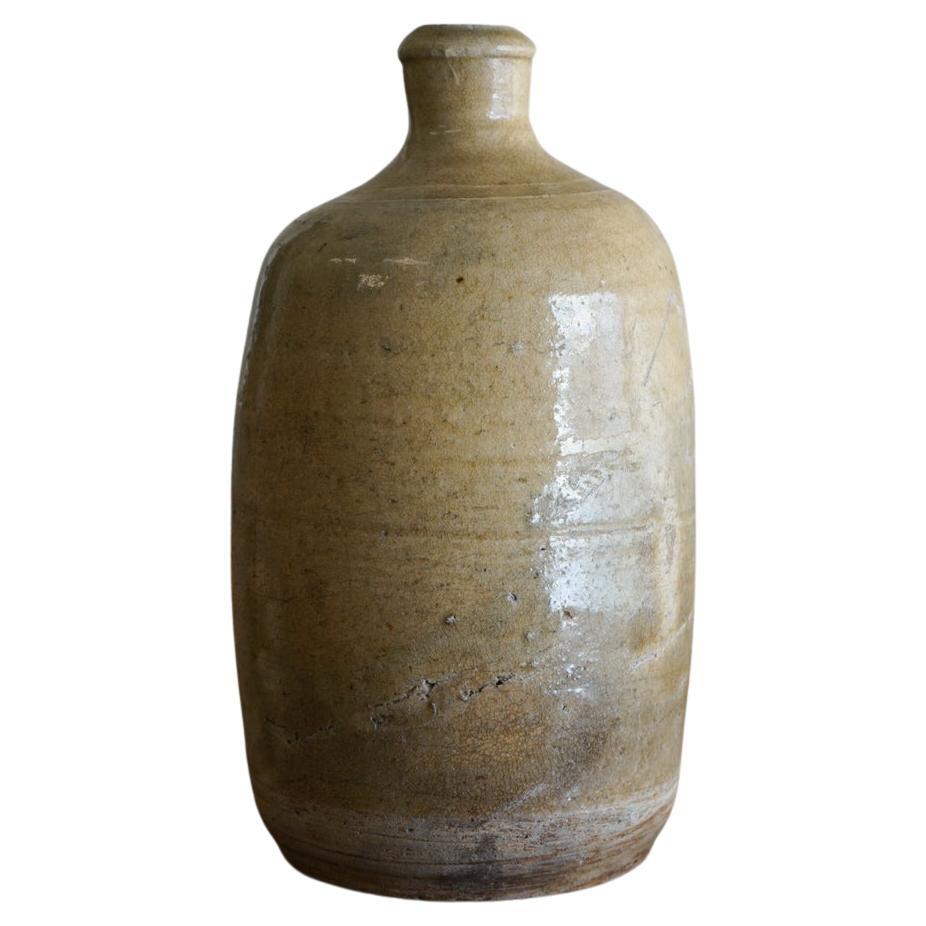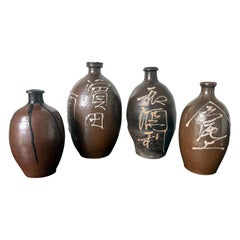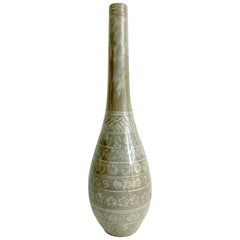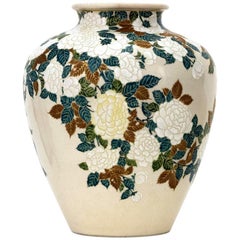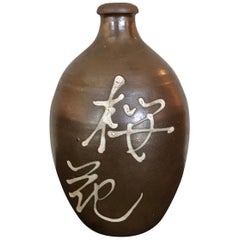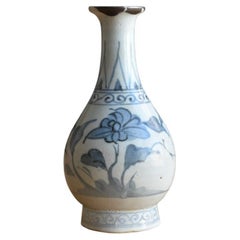Items Similar to Japanese Ceramic Sake Bottle Chosen Karatsu Ware
Want more images or videos?
Request additional images or videos from the seller
1 of 12
Japanese Ceramic Sake Bottle Chosen Karatsu Ware
About the Item
The long neck bottle of classic form was heavily potted with coarse clay with high iron content. The flask, circa 18th century Edo period, was purposed for sake storage but also substituted as a flower vase during tea ceremony. The surface is covered in glossy black glaze and contrasts strikingly with white ash glaze around the shoulder. The white, fired with straw, displays a splashing feather effect and fine crackles, blending in with the black artistically. This type of Karatsu ware was originally introduced by Korean potters who were forcefully brought to Japan after the invasion of Korea at the end of 16th century. They originally settled in Naeshirogawa and Tateno area (nowadays Satsuam) and kick-started the local pottery industry. Their techniques and aesthetics spread across Japan and left strong imprints on Japanese ceramics.
This sub-type Karatsu ware is such an example, known as Chosen or Korean Karatsu. On the base of the bottle, there are two old stickers. One shows the price in BP (British Pounds). The other states that the bottle is a black satsuma from Naeshirogawa circa 18th century. Our research contradicts this acclaimed origin and identifies the flask as being a Chosen Karatsu type. There is, however, strong artistic link between black satsuma ware and chosen karatsu as mentioned above because both were derived from Korean prototypes.
Reference: The Golden Age of Karatsu Stoneware by Francois Villemin. Page 74 and 159.
For a very similar piece see A New Yorker's view of the world: The John C Weber Collection. Cat no. 87 on page 256.
- Dimensions:Height: 10.6 in (26.93 cm)Diameter: 7 in (17.78 cm)
- Style:Japonisme (Of the Period)
- Materials and Techniques:
- Place of Origin:
- Period:
- Date of Manufacture:18th Century
- Condition:Wear consistent with age and use. Light surface wear with a couple of minute flakes on the glaze. Patina on the base.
- Seller Location:Atlanta, GA
- Reference Number:1stDibs: LU945016196382
About the Seller
4.9
Platinum Seller
These expertly vetted sellers are 1stDibs' most experienced sellers and are rated highest by our customers.
Established in 2006
1stDibs seller since 2010
520 sales on 1stDibs
Typical response time: 1 hour
- ShippingRetrieving quote...Ships From: Atlanta, GA
- Return PolicyThis item cannot be returned.
Authenticity Guarantee
In the unlikely event there’s an issue with an item’s authenticity, contact us within 1 year for a full refund. DetailsMoney-Back Guarantee
If your item is not as described, is damaged in transit, or does not arrive, contact us within 7 days for a full refund. Details24-Hour Cancellation
You have a 24-hour grace period in which to reconsider your purchase, with no questions asked.Vetted Professional Sellers
Our world-class sellers must adhere to strict standards for service and quality, maintaining the integrity of our listings.Price-Match Guarantee
If you find that a seller listed the same item for a lower price elsewhere, we’ll match it.Trusted Global Delivery
Our best-in-class carrier network provides specialized shipping options worldwide, including custom delivery.More From This Seller
View AllCollection of Four Japanese Tamba Tokkuri Sake Bottles
Located in Atlanta, GA
A set of four Japanese Ceramic Tokkuri Sake storage bottles circa early 20th century (Meiji to Taisho period). The bottles were made in Tamba (Tanba) kil...
Category
Early 20th Century Japanese Japonisme Ceramics
Materials
Ceramic
Japanese Ceramic Ikebana Vase Bizen Ware Nanba Koyo
Located in Atlanta, GA
A tall vintage ceramic vase with handle from Japan (20th century) by Nanba Koyo. Made in the tradition of Bizen ware, the vase has a modern aesthetic with a...
Category
20th Century Japanese Japonisme Ceramics
Materials
Ceramic
$1,500 / item
Japanese Mishima Ceramic Vase Meiji Period
Located in Atlanta, GA
A Japanese long neck slender ceramic vase in the style of Mishima, circa 19th century, Meiji period. Mishima pottery was originally imported from three islands in Taiwan and then fro...
Category
Antique 19th Century Japanese Japonisme Ceramics
Materials
Ceramic
Japanese Ceramic Vase by Ito Tozan I Meiji Period
By Ito Tozan I
Located in Atlanta, GA
This stoneware vase of a jar form was finely decorated with low relief carving and delicate colored glazes depicting bundles of peony flowers. It was made by Ito Tozan I (1846-1920) circa 1890-1900s in the late Meiji Period. The color pallet was both bold and subtle, with dark green and rusty leaves with golden outlines and white and light yellow peony petals covering much of the surface. Impressed with potter's mark on the base.
Examples of two pieces by Ito Tozan I were in the collection of MNAAG (Guimet) Paris. Inventory no. MG 13790 an 13792.
A vase with similar shape and decoration techniques is featured as Lot 1340 Fine Japanese Art, 13 Sep 2017 Bonhams New York
Tozan Ito I established his ceramic business in Kyoto 1867. His studio made both porcelain and stoneware in a style some considered Satsuma while they retained a sophistication of Kyoto ware...
Category
Antique 1890s Japanese Japonisme Ceramics
Materials
Ceramic
Korean Glazed Ceramic Vase Buncheong Ware Joseon Dynasty
Located in Atlanta, GA
A small antique Korean Buncheong stoneware vase from early Joseon Dynasty circa 16th century. The vase is of a classic pear form with a waisted neck, a flared mouth and a ringed base...
Category
Antique 16th Century Korean Other Ceramics
Materials
Ceramic
Japanese Ceramic Vase with Delicate Carvings by Makuzu Kozan Meiji Period
By Makuzu Kozan
Located in Atlanta, GA
A delicate and rare Japanese ceramic vase by the important Meiji imperial potter Makuzu Kozan (1842-1916) circa 1887-1910. Dated to his underglaze phase post 1887 after he successful...
Category
Antique 1890s Japanese Japonisme Ceramics
Materials
Ceramic
You May Also Like
Hand Painted Vintage Japanese Sake Bottle
Located in New York, NY
A beautifully shaped and glazed hand painted Japanese sake bottle with gorgeous calligraphy. A wonderful shelf piece.
Japan, circa 1960.
CR1006a.
Category
Mid-20th Century Japanese Ceramics
Materials
Ceramic
1610-1640/Japanese White Porcelain Blue and White Vase/"Imari Ware"/Sake Bottle
Located in Sammu-shi, Chiba
I bought a very nice vase with white porcelain and blue dye.
This is a sake bottle called Imari ware in Japan.
Imari ware is a kiln with a long history that began in the 17th cen...
Category
Antique Early 17th Century Japanese Edo Bottles
Materials
Porcelain
Japanese Antique Sake bottle Pottery Seto ware Edo era
Located in Chiba, Chiba
This is a Seto ware sake bottle made in the Edo period.
It is chipped in several places.
There are kiln marks from manufacturing, but there are no cracks or leaks.
It's also good for...
Category
Antique Mid-19th Century Japanese Ceramics
Materials
Ceramic
Kaneshige Toyo National Treasure Signed Japanese Bizen Pottery Sake Bottle Vase
Located in Studio City, CA
A beautiful, perfectly shaped and balanced antique Bizen ware shibui sake bottle (tokkuri) vase by renowned Japanese master potter/artist Kaneshige Toyo (1896-1967) featuring a unique natural, wonderfully textured organic forming ash glaze. Kaneshige is universally considered to be the founder of modern Bizen pottery.
In 1956, Kaneshige was certified as a Living National Treasure (Important Intangible Cultural Heritage) for his work in Bizen Ware pottery/ceramics. Bizen Ware is a type of Japanese pottery traditionally from the Bizen province, presently a part of the Okayama prefecture. It is considered one of the Six Ancient Japanese Kilns (along with Echizen ware, Seto ware, Shigaraki ware, Tamba ware, and Tokoname ware).
The piece is signed/ sealed on the base with one of Kaneshige's traditional incised marks.
A rather striking and engaging work. One of the best Kaneshige works we have come across. Scarce and hard to find in such an excellent condition. Would be a fantastic addition to any Japanese/Asian pottery or Bizen Ware collection or eye-catching stand-alone work in about any setting.
Kaneshige's work can be found in numerous prominent collections and museums including:
Aichi Prefectural Ceramic Museum, Seto, Japan
Brooklyn Museum, NY
Hagi Uragami Museum, Yamaguchi, Japan
Honolulu Art Museum, HI
Ibaraki Ceramic Art Museum, Kasama, Japan
Indiana Art...
Category
Mid-20th Century Japanese Showa Ceramics
Materials
Stoneware
Monumental Japanese Sake Vessel, c. 1850
Located in Chicago, IL
This elegant, large-scale vessel is a Japanese widemouth stoneware jar (kame) traditionally used for storing water and other liquids. This 19th-century example continues traditional ...
Category
Antique Mid-19th Century Japanese Meiji Ceramics
Materials
Porcelain, Stoneware
Japanese Meiji Period Early 20th Century Sake Bottle with Brown Patina
Located in Yonkers, NY
An antique Japanese Meiji period monochrome sake bottle from the early 20th century with concentric lines. Created in Japan during the Meiji period, this antique sake bottle captivat...
Category
Early 20th Century Japanese Meiji Bottles
Materials
Ceramic
Recently Viewed
View AllMore Ways To Browse
Japanese Ceramics
Ceramic Japan
Price In Japan
Antique Japanese Ceramics
Japanese Glazed Ceramic
Japanese Ceramic Pottery
Japanese White Ceramic
Old Bottles
Japan Ware
Black Ceramic Japanese
Antique Bottle Collection
Collection Of Antique Bottles
Japanese Ash
Black Japanese Pottery
Japanese Tea Ceremony
16th Century Japanese
Old Antique Bottles
Antique Bottle Display
